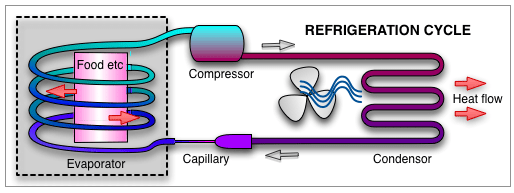Process of Refrigeration
By Anton Risse
Basic Mechanical Overview
A bare bone basic of how a common refrigerator works is
through a closed cyclic process. What this means is that
the refrigerant goes through a system of pipes in an out
of a compressor, and closed means that there is a specific
refrigerant that is "transporting" heat throughout
the system. What the refrigerant is is dependent on the
design, but it will be constantly turned into a gas and
then liquid repeatedly, so often something that can change
it's state of matter easily is used. This becomes a
compression and expansion cycle.
The actual power that goes to the refrigerator through an electric cable from a wall goes the compressor. The way the compressor works has to do with the relationship of pressure and temperature. When the refrigerant is compressed/under increased pressure, the refrigerant heats up. Once a temperature sensor in the refrigerator detects that it's cold enough, it will turn off the compressor. When it is warm enough, the compressor turns back on, and this process constantly repeats.
The Evaporator is an elongated pipe area that has cold refrigerant flowing through it, which cools the food inside the refrigerator by absorbing the heat from it, and sends the heated refrigerant back to the compressor. The condenser is an elongated part of the pipe from the compress that cools the gas back into a liquid with a fan blowing on the coil region of the condenser. If you stuck your hand outside this part of the refrigerator you will feel heat. The capillary flashes the liquid refrigerator through a tiny tube, turning it into a vapor that then goes into the evaporator section.
 https://i1.wp.com/greenlivingideas.com/wp-content/uploads/2014/09/fridge2.png
https://i1.wp.com/greenlivingideas.com/wp-content/uploads/2014/09/fridge2.png
The heat that comes out of the
The freezer
works with the exact same system of a refrigerator. The
way a freezer works in conjunction with a refrigerator is
by initially sending the coldest air to the freezer first,
then some remaining, less air to the refrigerator (Young,
P. 2015, October 09).
The actual power that goes to the refrigerator through an electric cable from a wall goes the compressor. The way the compressor works has to do with the relationship of pressure and temperature. When the refrigerant is compressed/under increased pressure, the refrigerant heats up. Once a temperature sensor in the refrigerator detects that it's cold enough, it will turn off the compressor. When it is warm enough, the compressor turns back on, and this process constantly repeats.
The Evaporator is an elongated pipe area that has cold refrigerant flowing through it, which cools the food inside the refrigerator by absorbing the heat from it, and sends the heated refrigerant back to the compressor. The condenser is an elongated part of the pipe from the compress that cools the gas back into a liquid with a fan blowing on the coil region of the condenser. If you stuck your hand outside this part of the refrigerator you will feel heat. The capillary flashes the liquid refrigerator through a tiny tube, turning it into a vapor that then goes into the evaporator section.
Visual representation of this whole
process:
 https://i1.wp.com/greenlivingideas.com/wp-content/uploads/2014/09/fridge2.png
https://i1.wp.com/greenlivingideas.com/wp-content/uploads/2014/09/fridge2.pngThe heat that comes out of the